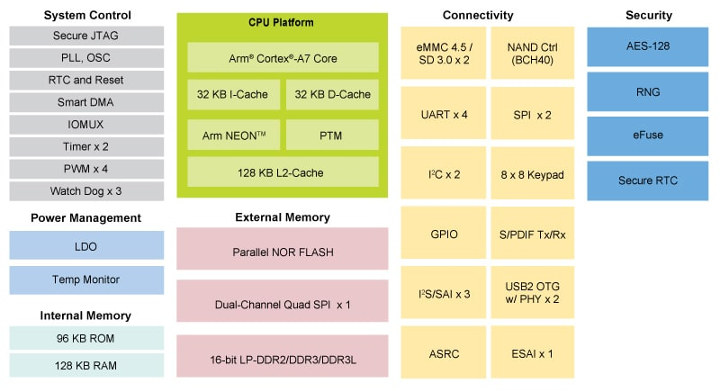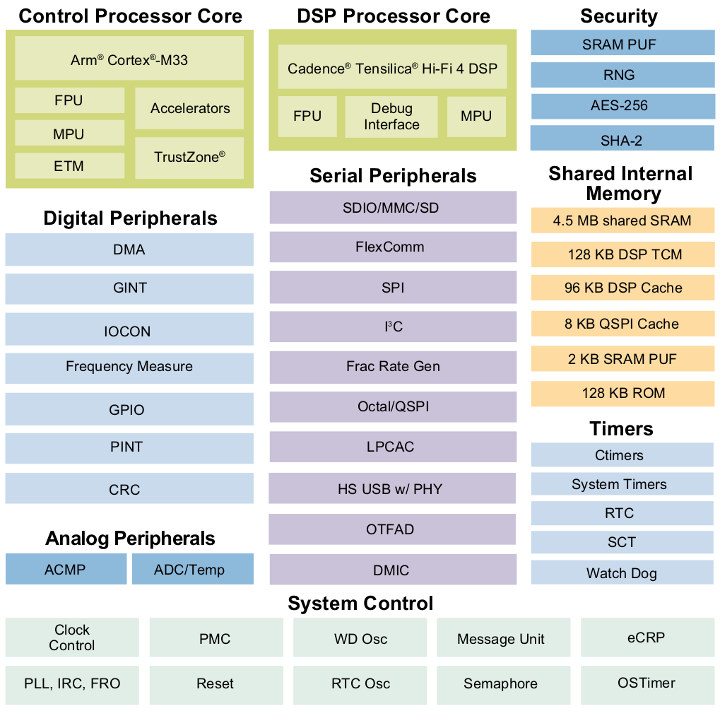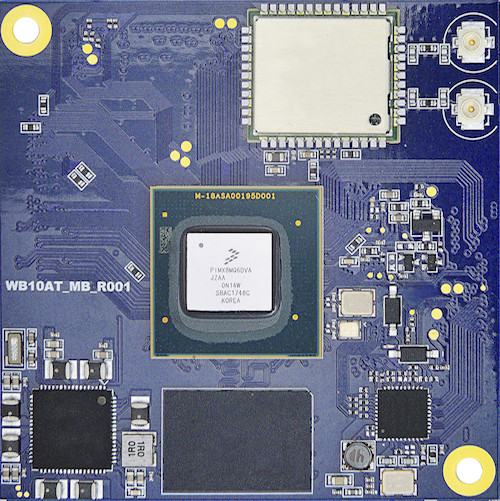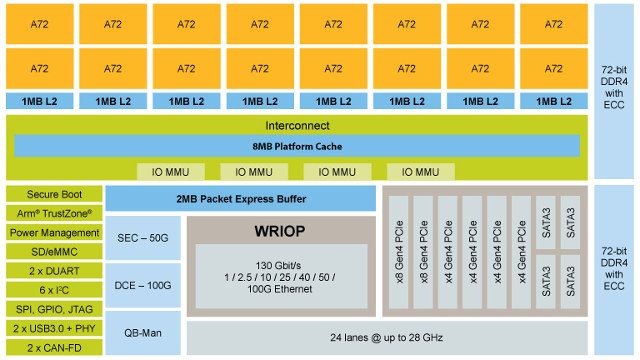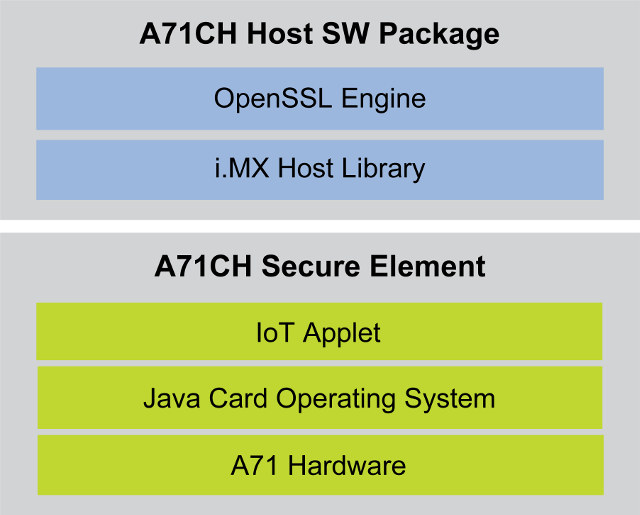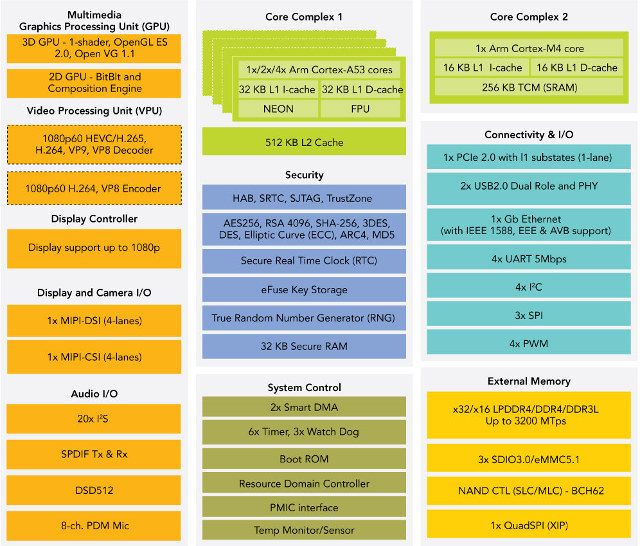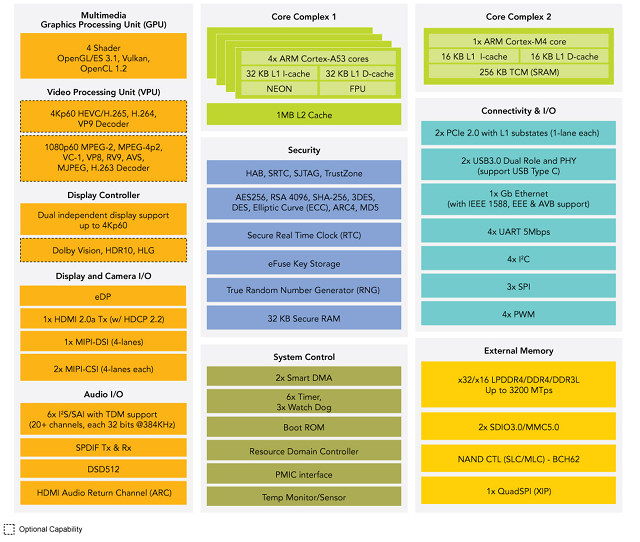Freescale i.MX 6 processor was first announced in January 2011, and in the first few years I covered many products and development boards based on the single to quad core Cortex A9 processor. Further down the road, the company became part of NXP, and launched Cortex A7 variant such as i.MX 6ULL providing both lower costs and power consumption. But now, I usually skip new products based on i.MX6 because they are often just more of the same, and not really new worthy. But yesterday while writing about Linux 4.20 release, I realized I missed the announcement of i.MX 6ULZ processor similar to i.MX 6UL (UltraLight), but cost optimized for applications that do not require Ethernet, display, nor camera interfaces. NXP i.MX 6ULZ key features and specifications with differences with i.MX 6UL highlighted in bold or stricken-through: CPU – ARM Cortex A7 core @ up to 900 MHz with 128KB […]
NXP Unveils i.MX RT600 Series Arm Cortex-M33 + Audio DSP Crossover Processor
A little over a year ago, NXP introduces their first crossover processor that blurs the line between real-time capabilities of microcontrollers and higher performance of application processors with NXP i.MX RT1050 processor equipped with a Cortex-M7 core clocked at up to 700 MHz. The company has now announced another model with lower power consumption. NXP i.MX RT600 series comes with a Cortex M33 core clocked at up to 300MHz, a Cadence Tensillica HiFi 4 audio DSP, and up to 4.5MB shared SRAM. Main features of NXP i.MX RT685 crossover processor: CPU Core – Arm Cortex-M33 up to 300 MHz DSP – Tensilica Hi-Fi 4 up to 600 MHz Memory Up to 4.5 MB on-chip RAM 128KB DSP TCM, 128 KB DSP Cache Storage 96KB ROM on-chip 2x SDIO with 1x supporting eMMC5.0 w/ HS400 1x Octal/Quad SPI up to 100MB/s Peripherals 2x DMA Engines with 35 channels each 1x USB […]
Android Things 1.0 Released with Support for NXP i.MX 8M, Qualcomm SDA212/SDA624 and Mediatek MT8516 SoMs
Brillo Project was renamed to Android Things with the release of a developer preview back in December 2014, and the operating system enabling developers and companies to build and maintain Internet of Things devices at scale. The OS has now graduated so-to-speak with the release of Android Things 1.0 with long-term support for production devices, and this was to be expected as several Android Things devices were announced earlier this year. The new release adds supports for new system-on-modules (SoMs) based on the NXP i.MX8M, Qualcomm SDA212, Qualcomm SDA624, and MediaTek MT8516 SoCs. These modules are certified for production use with guaranteed long-term support for 3 years, and development hardware and reference designs for these SoMs will be available in the coming months. The Raspberry Pi 3 Model B and NXP i.MX7D boards and system-on-modules are still supported, but support for NXP i.MX6UL devices will be deprecated. Check out the […]
NXP QorIQ LayerScape LX2160A is a 16-core Arm Cortex A72 Communication Processor with 100 Gbit/s Ethernet
NXP Semiconductors has been working on a high-end communication processor with their QorIQ LayerScape LX2160A SoC equipped with 16 Arm Cortex A72 cores, 16 Ethernet ports supporting 1 to 100 Gbit/s, as well as 24 PCIe Gen4 lanes, and four SATA 3.0 ports. NXP LX2160A key specifications / features: Processor – 16x Arm Cortex-A72 CPU cores, running up to 2.2GHz with 8MB L2 cache, 8MB platform cache Memory I/F – 2 x DDR4 72b including ECC, up to 3200 MT/s, maximum capacity of 256 GB Storage – 4 x SATA3.0 Ethernet Up to 16 Ethernet ports Supported Ethernet speeds include 1, 2.5, 10, 25, 40, 50, and 100 gigabits per second 130Gbps Layer 2 Ethernet switch PCIe – Up to 24 PCIe Gen4 lanes, supporting ports as wide as x8 24 SerDes lanes, operating up to 28GHz Acceleration Engines – 50Gbps security accelerator, 100Gbps data compression/decompression engine Security – Secure […]
NXP Unveils A71CH Secure Element Chip for Secure Peer-to-Peer or Cloud Connections
The industry clearly has an issue at hand with the security of the Internet of Things, and the problem is complex as some devices are easily accessible due to bad configuration (e.g. default username/password), while others may have security flaws at various levels of the software stack from the low level bootloaders to the operating systems, and applications. Nowadays, devices also need to be upgradeable, and communicate with the cloud, and that introduces other attack vectors in case malignant firmware is installed instead, or a man-in-the-middle attack occurs. While some people may claim security can be achieved by software only, we are seeing security evolving towards combined software and hardware solutions, for example with Arm Trustzone built into SoCs, but some companies are also introducing Secure Element chip, which Samsung has already done and integrated into their Artik modules to secure data from the hardware to the cloud. NXP has […]
NXP i.MX 8M Mini Low Power Cortex A53/Cortex M4 Processor to be Manufactured using 14LPC FinFET Process Technology
NXP i.MX 8, i.MX 8M, and i.MX 8X processors are barely available, but the company has already announced another member of their i.MX8 family with i.MX 8M Mini processors with one to four Cortex A53 application cores, one Cortex-M4F real-time core, 2D/ 3D graphics accelerator, and support for 1080p video playback and output. Apart from the lack of 4K support, that looks about the same as i.MX 8, but there’s one important difference: the manufacturing process. i.MX 8M Mini processors are manufactured using 14LPC FinFET process technology allowing the Cortex A53 cores to reach 2.0 GHz, and the Cortex-M4F core can be clocked up to 400+ MHz. Some video interfaces have also been removed from the new processor such as embedded DisplayPort and HDMI 2.0a. NXP i.MX 8M Mini key features: Application cores – One to four Arm Cortex-A53 cores up to 2GHz Real-time core – Arm Cortex-M4 at speeds […]
Develop NXP i.MX 8M Voice Controlled Smart Devices with MCIMX8M-EVK Evaluation Kit
We first heard about NXP i.MX 8M processsors in October 2016, and at the end of last year, WandPi 8M development board was unveiled with shipping scheduled for Q2 2018 once the processor will start manufacturing. Other exciting i.MX 8M projects include Purism Librem 5 smartphone, MNT Reform DIY modular computer, and I’m sure there will be others development board & products, and plenty of system-on-modules introduced with the processor in 2018. NXP i.MX 8M processor also got in the news at CES 2018, because it will be one of the hardware platforms certified for Android Things, and NXP also issued a press release to announced the processor’s multimedia capability with be used in voice controlled devices with or without video. The PR refers to Gartner Research saying that “voice commands will dominate 50 percent of all searches in the next two years”, and explains that with thinner and thinner […]
NXP Announces OpenIL Industrial Real-Time Linux Distribution for Industry 4.0
NXP has announced the release of OpenIL industrial Linux distribution with real-time OS extensions and Time-Sensitive Networking (TSN) support for factory-automation for the Industry 4.0 era. The OpenIL distribution includes support for per-stream policing, time-aware shaping of network traffic, and 801.1AS time synchronization, and supports NXP Layerscape SoCs and boards such as LS1028A dual ARMv8 processor, or LS1021A-IOT IoT gateway. Some notable OpenIL features include: Xenomai real-time extensions to Unix, making porting relatively easy from an RTOS like VxWorks or pSOS Extensible Markup Language (XML) and NETCONF-based network configuration utilities for TSN Generalized precision time protocol (gPTP) with the linuxptp daemon Drivers for the Ethernet Interfaces and the NXP SJA1105T TSN switch Support for edge computing services Optional instantiation of the Ubuntu user-space filesystem layout You’ll find the source code on Gihub, and some more information on OpenIL.org website. NXP appears to be the only company involved in the project, […]


